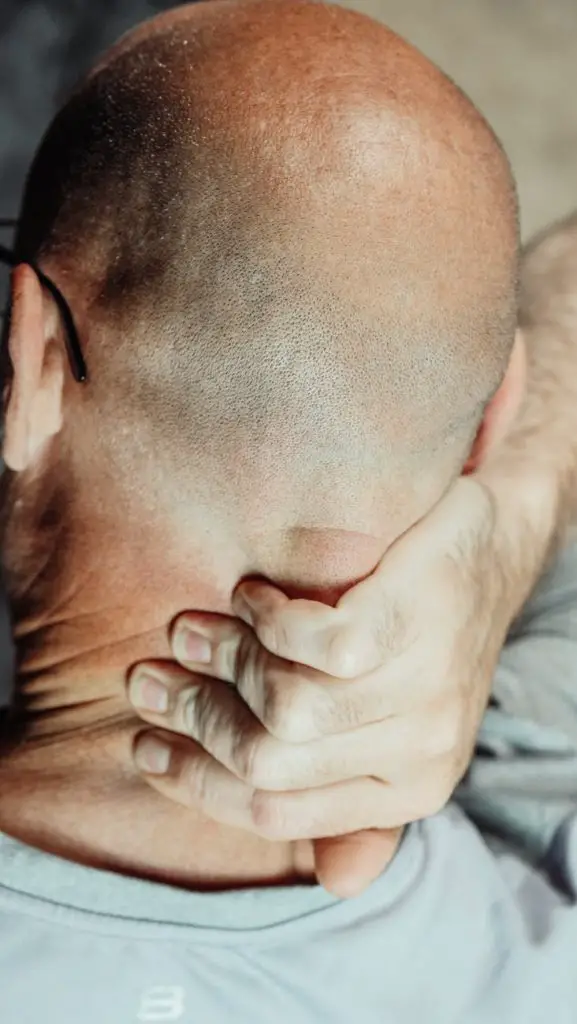Article reviewed and approved by Dr. Ibtissama Boukas, physician specializing in family medicine
Uncodiscarthrosis or uncocervicarthrosis is a bone disease that affects the majority of older people. It is also associated with lesions of intervertebral discs located at the neck. Biological age is the main and unavoidable cause of this pathology.
What is uncodiscarthrosis? What are its causes and the factors that aggravate it? How to recognize uncocervicarthrosis ? What tests are useful to confirm the diagnosis? And finally, what treatments are available for treat this type of neck pain ? Find the answers to these questions in this article.
Definition of uncodiscarthrosis
THEuncodiscarthrosis is a medical term which designates an osteo-articular pathology corresponding to a degeneration of the cartilage and the uncus at the level of the vertebrae lower cervical. We speak in particular of the third to the seventh vertebrate.
The uncus are small bony growths which are observed particularly on the cervical vertebrae. They are located on both sides of the vertebral body. They serve to connect two adjacent cervical vertebrae and maintain the stability of the latter. The uncus may be affected by osteoarthritis lesions and abnormal ossification (uncarthrosis). Natural wear of bones and cartilage means uncodiscarthrosis.
This vertebral condition is common among seniors. On average, it affects 60% of people over 60 and 25% of people under 40.
What are the main causes of uncodiscarthrosis?
Le aging is the main cause of uncodiscarthrosis. The latter is linked to two main mechanisms.
- Cervical discarthrosis or cervicarthrosis: it corresponds to the wear of the discs between the cervical vertebrae. With age, the discs become fragile, decrease in height and become dehydrated. This change leads to herniated discs or disc protrusions (bulging of the circumference of the disc).
- A degeneration of the uncus or a carthrosis: it results in fissures of the fibrous annulus of the disc.
The other probable causes of uncodiscarthrosis are :
- History of cervical trauma;
- Bad postures;
- Lack of physical activity;
- A genetic predisposition;
- congenital anomalies of the spine ;
- Repeated microtrauma...
Apart from age, people at risk of developing uncodiscarthrosis are those who carry out a professional activity in a static sitting position and those who are too sedentary.
What are the symptoms of uncodiscarthrosis?
The first symptoms of uncodiscarthrosis are neck pain and stiffness in the neck. These pains will limit the amplitude of your movements such as the inclination or the rotation of the neck. In this case, it is common to appreciate contractures in the paravertebral muscles.
When you suffer from uncodiscarthrosis, you may also experience nerve pain. Indeed, the affected vertebrae can sometimes move and compress the root of one of the surrounding nerves. In some patients, the development of an osteophyte or bony growth around the altered uncus may also cause the nerve to be compressed.
This phenomenon results in severe pain that spreads to the back, shoulder blade, arms, and shoulders. There may also be upper extremity paresthesias (such as ants in hands).
Osteophytes can also compress an artery. This phenomenon is an obstacle to blood circulation to the brain and causes headaches and dizziness.
These symptoms are accompanied by:
- tingling;
- numbness in the shoulders, neck, back and trapezius muscles;
- motor difficulties of the upper limb…
When uncodiscarthrosis is poorly managed, it can lead to complications such as:
- chronicity;
- severe permanent and disabling pain;
- root damage;
- motor difficulties;
- spinal stiffness.
Severe cases of cervical discarthrosis (what risks?)
If a patient suffers from severe inflammation and nerve damage as a result of a uncodiscarthrosis cervical, the prognosis is more unfavorable.
This can translate to:
- Intense neck pain;
- Neurological signs in the lower limbs;
- Significant weakness in the limbs;
- Electric shocks;
Additionally, this condition can also irritate thevertebral artery and cause a vertebro-basilar insufficiency.
THEvertebro-basilar insufficiency is a condition in which blood flow to the brain is reduced. As a result, patients may experience dizziness, vertigo, and even strokes.
It is therefore important to consult a doctor if you experience any of these symptoms. While cervical discarthrosis can be a serious condition, early diagnosis and treatment can improve prognosis.
How is this neck pain diagnosed?
In case of uncodiscarthrosis, it is important to consult a doctor. He performs clinical examinations and prescribes additional examinations necessary for the diagnosis and evaluation of vertebral pathology.
The clinical examination is based on a neck mobility test, as well as the evaluation of reflexes and sensitivity. The goal is to assess whether a nerve is affected or not. This examination also measures pain. It is therefore essential, because it makes it possible to assess the clinical severity of uncodiscarthrosis in addition to limiting incriminating other causes such as trauma, infection, inflammation or tumor.
A biological assessment by a blood test can also be requested if there is any doubt concerning the diagnosis ofuncocervicarthrosis.
Definitive diagnosis of uncodiscarthrosis is based on imaging tests. A x-ray of cervical spine is indicated first. This helps to show signs of cartilage and uncus wear.
A CT scan or MRI of the cervical spine may also be necessary to assess the state of the intervertebral discs as well as the uncus. These examinations may also show root compression. In this case, the health of the muscles and the nerve cells that control them are assessed by electromyography (EMG).
Treatments: how to relieve the symptoms of uncodiscarthrosis?
Le treatment of uncodiscarthrosis usually depends on the symptoms and their intensity. This is a symptomatic treatment which will be reassessed regularly as the pathology progresses. Indeed, uncodiscarthrosis cannot completely disappear. However, steps can be taken to relieve pain and limit the development of the disease.
Above all, the doctor prescribes relative or total rest at patient suffering from a codiscarthrosis in order to reduce pain and limit the pressure exerted on the cervical spine.
Analgesics, anti-inflammatory and muscle relaxants are prescribed to reduce pain. Only, they should not be taken over a long period, especially anti-inflammatories which can cause side effects. An injection of corticosteroids may be indicated in case of disabling or chronic pain.
A paramedical therapy is also recommended in case of uncodiscarthrosis. A few sessions of physiotherapy or osteopathy would do the greatest good for relieve patient neck pain. These therapists help a lot to improve the mobility of the cervical spine, and to reduce the stresses applied to the spine. The therapist offers you gentle exercises and gives many essential tips.
In physiotherapy, you will be required to perform stretching and strengthening of neck and shoulder muscles. You will practice traction techniques to reduce the pressure exerted on the nerve roots only if you feel a cervico brachial neuralgia.
Since the pain of uncodiscarthrosis is exacerbated by poor posture, the use of a good pillow such as a ergonomic pillow would be a good idea. It will allow the neck and head to relax by providing a healthy posture during your sleep. In addition, it offers you a perfect alignment of your neck, head and spine. The head should not be too elevated.
Furthermore, it is quite possible to prevent uncodiscarthrosis. The best way to do this is to adopt good posture, whatever your daily activity. It is also advisable to do moderate physical activity regularly and to avoid sports that are too intense.
As uncodiscarthrosis develops with age, there are ways to slow its progression, namely:
- regularly perform stretching and muscle strengthening exercises;
- stay hydrated (little scientific evidence but still good);
- avoid risk factors (vibration, repeated shock, etc.).
Surgical intervention is recommended only in case of severe root compression or in case of motor deficit. Wearing a semi-rigid cervical collar may thus be possible in certain cases.
Roles and benefits ofosteopathy
THEosteopathy is a form of manual medicine that uses various techniques to diagnose and treat problems related to the muscles, bones and joints of the body. Osteopaths believe that the body is a self-healing organism and that by manipulating the skeleton and muscles they can help the body heal itself.
THEosteopathy is a popular form of treatment for a wide range of conditions, including back pain, neck pain, joint pain, and headaches. It is also used to treat chronic conditions such as asthma and arthritis. L'osteopathy is considered a safe form of treatment and is often recommended as the first line of treatment for many conditions.
The main advantages ofosteopathy are that it is a safe and effective form of treatment for a wide range of conditions. L'osteopathy can help relieve pain and improve mobility of affected areas, which can lead to a better quality of life for patients.
Cervical manipulations in the osteopath, what risk?
The manipulations of the cervical spine, although infrequent, can lead to a number of risks and complications. The most serious of these is stroke, which can be caused by injury to thevertebral artery.
This is a rare complication, however, and is more likely to occur in patients who are already at risk for stroke. Other risks associated with cervical manipulation are neck pain and headaches.
Despite these risks, cervical manipulation is generally considered a safe procedure. The incidence of serious complications is low, and most of those that do occur are mild and easily treated.
Patients should always consult their doctor before undergoing any type of manipulation of the spine, but for the average healthy individual, the risks posed by this procedure are minimal.
What are the factors that increase the risks?
The risks of handling cervical spine, although low, may increase in some patients. Patients at higher risk of complications are those who have:
- Osteoporosis: it is a disease that affects the bones and increases the risk of fractures.
- A history of cervical fracture increases the risk of complications related to manipulation of the cervical spine.
- People who have a history of neck pain are also at an increased risk of complications.
- People with a history of headaches may also be more susceptible to the negative effects of cervical spine manipulation.
- People with circulatory problems or autoimmune problems are also at increased risk of complications.
Un qualified therapist will be able to weigh the pros and cons of cervical spine manipulation and decide whether it is better to use this technique or others. L'osteopathy is a form of manual medicine that can help relieve pain and improve mobility in affected areas. It is therefore often recommended as first-line treatment for many conditions.
Uncodiscarthrosis and sport
If you suffer from cervical discarthrosis, it is always important to follow the recommendations of your doctor. He will know which activities are safe for you and which ones you should avoid.
- Start with low-risk activities like swimming, walking, and elliptical training. These activities will allow you to increase your range of motion and strengthen your neck muscles without putting too much strain on them.
- Then, avoid contact sports until your doctor gives you the go-ahead to resume them.
- Third, see your doctor if any new symptoms appear, such as numbness, weakness, paralysis, or pain.
- Fourth, the psychological aspects of uncodiscarthrosis are also important to consider. As much as possible, try to avoid kinesiophobia, the fear of movement. This mindset can be difficult to overcome, but it's important to remember that overprotecting the cervical region can lead to long-term stiffness and weakness.
- Finally, pay attention to your posture and exercise regularly. Follow the recommendations of a physiotherapist (physiotherapist) can help you reduce the symptoms of uncodiscarthrosis and improve your overall health.
Sources
https://www.medisite.fr/uncodiscarthrose-definition-causes-symptomes-traitements.5556399..html


